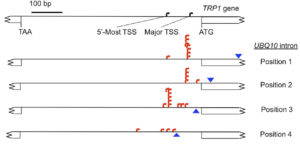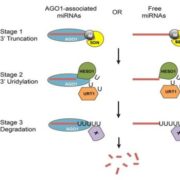A Surprising Function for Gene Introns
Gallegos and Rose investigate how introns affect transcript initiation http://www.plantcell.org/content/29/4/843.abstract.
For the information stored in the DNA of genes to be converted into functional protein products, first a molecular copy of the information called messenger RNA is made, using DNA as a template in a process called transcription. Messenger RNA molecules are then translated into proteins. Every gene contains numerous short stretches of DNA that are recognized as regulatory elements. These include a promoter region near a defined transcription start site, where the protein complexes involved in transcription bind to the DNA and begin to transcribe the message, and a variety of other elements that bind proteins that act to inhibit or enhance transcription, and thereby turn genes “on” or “off”.
The production of messenger RNA involves several intermediate processing steps including the removal of large sections of the RNA called introns. Even though introns are removed from the mature messenger RNA, some introns have dramatic effects on the amount of messenger RNA produced. Some genes are completely inactive – in other words transcription will not be initiated – if certain introns are deleted, and most genes make more RNA than usual if a “stimulating intron” is added. This phenomenon is called “intron-mediated enhancement” of transcription.
 The mechanism remains a mystery, but stimulating introns have a few key features. For example, introns only increase the production of messenger RNA when they are located close to the transcription start site, and they stop working when moved farther away from the start site. Gallegos and Rose set out to define the boundaries of stimulating introns more precisely, to learn more about how introns work to enhance transcription. They found that different positions had different effects on the amount of messenger RNA produced, and also the position at which RNA production started. The authors also tested the importance of the gene promoter region, which normally is thought to exert major control over RNA production. Remarkably, deleting the promoter sequence altogether had no effect on the amount of messenger RNA produced if the gene included a stimulating intron.
The mechanism remains a mystery, but stimulating introns have a few key features. For example, introns only increase the production of messenger RNA when they are located close to the transcription start site, and they stop working when moved farther away from the start site. Gallegos and Rose set out to define the boundaries of stimulating introns more precisely, to learn more about how introns work to enhance transcription. They found that different positions had different effects on the amount of messenger RNA produced, and also the position at which RNA production started. The authors also tested the importance of the gene promoter region, which normally is thought to exert major control over RNA production. Remarkably, deleting the promoter sequence altogether had no effect on the amount of messenger RNA produced if the gene included a stimulating intron.
The idea that introns can be more important than promoters in controlling RNA production is new. The main challenge now is to understand the mechanism through which introns boost RNA production. This could involve looking for proteins that specifically interact with introns, or testing the effect of introns on the RNA production machinery or the three dimensional structure of genes.
Gallegos, J.E., and Rose, A.B. (2017). Intron DNA Sequences Can Be More Important Than the Proximal Promoter in Determining the Site of Transcript Initiation. Plant Cell 29: 843-853.










Leave a Reply
Want to join the discussion?Feel free to contribute!